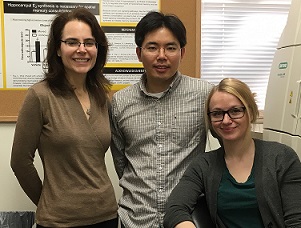|
In This Issue...
- Featured Research
- Budapest is right around the corner!
- Vote in the 2016 IBNS Elections by April 25!
- Trending Science
- IBNS 2016 Budapest Tours
- Member News
Featured Research
By Karyn Frick

Dr. Karyn Frick’s research group at the University of Wisconsin–Milwaukee published two recent papers in Journal of Neuroscience, that together, expand on the complexity and functional role of estrogen signaling in the hippocampus. Estrogens have long been known to regulate memory function, but the mechanisms through which they do so are unclear. One of the goals of research in Karyn Frick’s lab is to pinpoint the molecular mechanisms through which 17β-estradiol enhances hippocampal memory in females. The Frick lab’s two most recent papers published in The Journal of Neuroscience identify cell signaling and receptors mechanisms underlying the estrogenic regulation of dendritic spine density and memory.
In the first paper (Tuscher et al., 2016, J Neurosci, 36(5):1483-1489), Dr. Frick and graduate student Jennifer Tuscher, with collaborators Maya Frankfurt (Hofstra North Shore-LIJ School of Medicine) and Victoria Luine (Hunter College), examined the involvement of dorsal hippocampal extracellular signal-regulated kinase (ERK) and mammalian target of rapamycin (mTOR) signaling mechanisms in estrogenic regulation of dendritic spine density in the hippocampus and cortex. The Frick lab previously showed that activation of ERK and mTOR in the dorsal hippocampus is necessary for estradiol to enhance spatial memory and object recognition in ovariectomized female mice. In their new paper, Tuscher and colleagues first found that dorsal hippocampal infusion of estradiol selectively increases dendritic spine density in hippocampal CA1 within 30 minutes and the medial prefrontal cortex within 2 hours. Next, the group found that activation of ERK or mTOR signaling in the hippocampus is also necessary for estradiol to increase dendritic spine density not only in the hippocampus, but also the prefrontal cortex. Thus, this study is the first to show that cell signaling regulates estradiol-induced spine formation in the dorsal hippocampus, and that this hippocampal spine formation drives spinogenesis in the prefrontal cortex.
In the next study (Kim et al., 2016, J Neurosci, 36(11):3309-3321), graduate student Jaekyoon Kim and others from the Frick lab examined the role of the membrane estrogen receptor G-protein-coupled estrogen receptor (GPER) in mediating the memory-enhancing effects of estradiol in ovariectomized female mice. Previous work from the Frick lab showed that activation of the canonical intracellular estrogen receptors, ERα and ERβ, in the dorsal hippocampus mimics the effects of dorsal hippocampal estradiol infusion on memory; like estradiol, agonists of ERα and ERβ enhance object recognition and spatial memory by increasing dorsal hippocampal ERK phosphorylation. Kim and colleagues extended this work to show that activation of GPER in the dorsal hippocampus also enhances object recognition and spatial memory. However, Kim et al. found that this memory-enhancement was not dependent on activation of ERK in the dorsal hippocampus, but rather on c-Jun N-terminal kinase (JNK). The ability of estradiol to enhance hippocampal memory was not dependent on either JNK or GPER activation, indicating that estradiol and GPER independently regulate hippocampal memory. These data suggest the intriguing conclusion that GPER does not function as an estrogen receptor in the dorsal hippocampus to regulate memory consolidation.
Together, these new findings provide novel insights into the molecular mechanisms through which estradiol mediates the function of the hippocampus and prefrontal cortex. Because women are at greater risk of developing age-related memory decline and dementia than men, this knowledge could facilitate the development of new therapies to prevent or reduce memory dysfunction in older women.
Budapest is right around the corner!
IBNS Annual Meeting, June 7-12, 2016, Kempinski Hotel, Budapest, Hungary. Hear from the best in our various fields of study, network with scientists and researchers from all over the world, present your work and enjoy the historic surroundings that Budapest, Hungary, and the Kempinski Hotel have to offer. More info at: http://www.ibnsconnect.org/meetings
Email the event flyer to your friends and colleagues, inviting them to attend HERE.
Vote in the 2016 IBNS Elections by April 25!
IBNS 2016 Elections are underway and all member ballots must be cast by April 25th. If you are a member of IBNS, review the candidates and cast your votes for 2016 IBNS Elections TODAY!
Trending Science
In this column, we will share the latest research, interesting scientific articles and news you can use.
Pesticides Produce Autism-like Brain Changes...
Research from Dr. Brandon Pearson (formerly of the Blanchard's group) was recently published in Nature Communications reporting a link between pesticide exposure and neural changes in mice similar to those seen in humans with autism. This work, performed during his postdoc in the laboratory of Dr. Mark Zylka at the University of North Carolina - Chapel Hill, was highlighted by the Spectrum news. Read the article
IBNS 2016 Budapest Tours
See the sites of Budapest, Hungary, while attending IBNS 2016...join an IBNS group tour! We are offering three tours to all attendees at group discounted pricing. Use this opportunity to see the sites just before the meeting and network with fellow attendees. Choose from a full-day tour on Monday, June 6, or choose one of two half-day tours on the afternoon of Tuesday, June 7. Interested in seeing the sites with us? Review the tours and sign up via the link:
IBNS 2016 Pre-Conference Tours
Member News
In this column, we share news of our members' accomplishments, career advancement, awards and honors. Submit your member news to [email protected] for our next issue.

We recognize Dr. Jared Young for his promotion to Associate Professor at UCSD. He has recently been awarded a UH2/UH3 NIH grant to investigate EEG biomarkers of RDoC-relevant behavioral domains of functioning in mice and humans.

We would also like to congratulate Dr. Greg Sartor for his K99 NIH grant or research investigating epigenetic mechanisms of addiction.
Please send in your member news for our next edition!
|